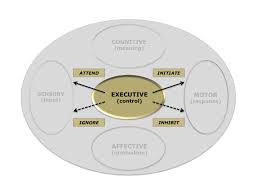Cognitive control, as I mentioned in previous posts, refers to the ability to perform a task in real operating conditions. For instance, an L2 learner of French who has had only a few lessons on the Passé Composé may be able to conjugate the verb ‘Aller’ perfectly in the context of a gap-fill exercise; however, when required to use it in spontaneous speech he will produce wrong utterances like ‘J’allé’ or ‘J’ai allé’. Most experienced teachers will be very familiar with this phenomenon – and with this specific mistake.
The reason for the mistake is that the learner has not yet acquired cognitive control over that specific form of the Passé Composé; he has a clear idea of how to form it, has the correct mental representation of the rule (or Declarative knowledge, as Skill theorists call it), but cannot apply it in real time when his brain has to juggle all of the following demands in the very short time available to him to ‘stay’ in the conversation:
- Understand what the person he is talking to is saying;
- Plan what to reply;
- ‘Fetch’ from Long-term Memory the French words that match that plan;
- Arrange the words into a syntactically correct sentence;
- Store that sentence in Working Memory;
- Modify word endings when necessary (i.e. verbs must be conjugated, feminine/plural endings added, etc.),
- Evaluate its accuracy, which means monitoring the sentence whilst rehearsing it in Working Memory;
- Pronounce it correctly.
This is a tall order for a novice foreign language speaker as it requires the ability to orchestrate many skills at the same time. Teachers often take it for granted as they are, after all, very good linguists and may not remember how they themselves struggled with that as learners…
To go back to the example I gave at the very beginning of this article, what is ironic is that what the student who gets the ‘je suis allé’ wrong in spontaneous speech will often get by his teacher is a reminder of the rule – that the boy already knows – and more gap-fill exercises – which will not prepare him for effective performance in spontaneous speech at all.
But how do we develop L2 learners’ high levels of executive control (also called ‘Procedural Knowledge’) over a given structure or skill? Surely not simply by getting them to memorize scores of conjugation tables and practice through gap-fill exercises. These activities can be useful as a starting point along the acquisition continuum, but ultimately, the only way to acquire the ability to apply a grammar rule in real operating conditions (i.e. spontaneous speech; essay writing under timed conditions; chatting on the web, etc.) is practice which starts with very easy recognition tasks and culminates several lessons later into more challenging unplanned communicative tasks (e.g. spontaneous conversation). This is an example of a sequence of (easy-to-prepare) activities to develop control in speaking for a year 9-10 class, which would take at least three lessons:
- Presentation / Modelling of the target rule: Explicit (e.g. typical Power Point presentation explaining the rule) or Inductive (e.g. students are given a text or sentences with examples of the target rule and they must work it out by themselves)
- Lots of receptive practice where students see examples of the target grammar structure’s application in the context of a written passage;
- Gap-fill exercises and/or audiolingual-style drills (e.g. students are simply required to repeat a set sentences but change a verb or adjectival ending)
- Easy (English to French) oral translations (e.g. students are given very basic role-plays in English to put into French orally);
- Picture-based tasks (i.e. given a very clear and simple picture, students have to briefly describe it using the target structure);
- Structured ‘narrow’ tasks eliciting basic responses containing the target structure (e.g. basic conversations, surveys or ‘Find someone who’ tasks including questions such as ‘Qu’est-ce que tu as fait hier soir au cinema?’);
- Challenging GCSE style role-plays with cues eliciting the target structure;
- Typical unstructured communicative tasks eliciting spontaneous speech (e.g. GCSE style conversation tasks)
As the above sequence clearly show, the implication is that the acquisition of high levels of executive control over any grammar structure requires a lot of practice through a model that goes from ‘easy’ receptive tasks, to gradually more challenging production tasks which are fairly easy and highly structured to start with and become increasingly demanding on Working Memory capacity. In my experience, learners are way too often required to skip steps and go much too soon from the gap-fill / easy permutation stage to fairly challenging GCSE conversation-like tasks. This is very much the equivalent, in real life, to showing a person how to drive in a motionless car and ask them a few minutes later to drive the same car flat out on a trafficked highway.
In conclusion, the notion of control that I have dicussed in this article should be heeded by language instructors to a much greater extent than it is currently done in many L2 classrooms. One would not claim to be able to play tennis after reading a book about it, or after having bounced the ball with one’s racket against a wall a few times. However, this is pretty much what many teachers do when they limit their teaching of grammar to a presentation of the rule, a few gap-fills and one or two rounds of questions around the class to check understanding – followed maybe by a short essay or narrative eliciting the use of the target structure.
The achievement of high levels of procedural knowledge must be the ultimate goal of foreign language learning; hence, the development of effective cognitive control must be at the heart of everything we do in every lesson.


You must be logged in to post a comment.